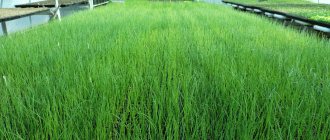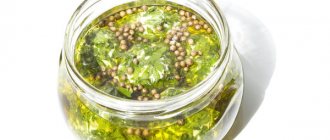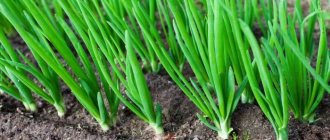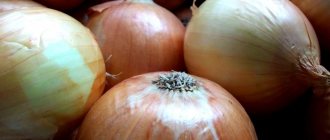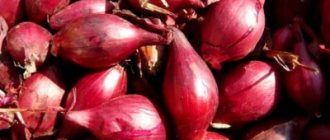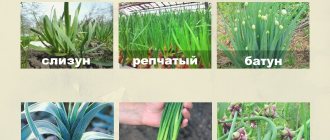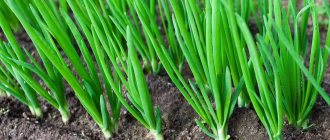Most gardeners grow green onions on their plots. Its greens contain many vitamins and minerals. The leaves of the plant are not only healthy, but also tasty. They have a characteristic onion aroma and piquancy, but not as rich as in the case of root vegetables. In summer and autumn, such greens sometimes completely replace regular onions.
To achieve high yields, specially designed varieties are chosen for feather forcing. In this case, the plant will spend energy and nutrients on greens, and not on turnips. Read on to learn how to choose the right variety and grow green onions from seeds.
Suitable varieties of onions for greens
To get a rich harvest of greens, choose onion varieties specifically designed for forcing the feathers. As a rule, they do not form roots, but have a thick green mass.
There are several varieties of onions that are suitable for forcing feathers. These include:
Batun
Perennial. It is distinguished by large cone-shaped feathers. All greenery is the same height. The onion aroma and pungency are pronounced. Feathers are cut several times per season. The seed pods of this type of onion must be cut off, which negatively affect the taste of the greens.
The varieties of batun for feather forcing include: April, Baron, Baia Verde, Izumrudny, Tenderness, Russian size, Seryozha, Russian winter. All varieties are frost resistant. Their yield varies between 3.5-4 kg per 1 m².
Leek
It has flat, wide leaves reminiscent of garlic leaves. It has a delicate onion aroma and a slightly spicy taste. Has average resistance to cold weather. It is grown only in the garden.
Varieties suitable for feather forcing include: Vesta, Casimir, Calambus, Sizokryl, Pobeditel, Alligator, Elephant, Tango. Productivity varies between 2-3 kg per 1 m².
Chives
It has thin cone-shaped feathers that resemble needles. They are tender and juicy, with a slight tang and a characteristic aroma. Feather length - 30-50 cm. Suitable for growing at home and in the garden. It has bright fragrant inflorescences that attract pollinating insects.
All varieties are resistant to cold weather and immune to diseases. Varieties of chives suitable for forcing feathers include: Prazhsky, Bohemia, Siberian, Khibinsky, Chemal, Honey plant, Vesenny. Productivity varies between 3-4 kg per 1 m².
Shallot
It has a delicate onion aroma and a sweet-spicy taste. The feathers are cone-shaped, thicker than those of chives, but thinner than those of batun. Frost resistance is low, immunity is average. Productivity - up to 2 kg per 1 m². The following varieties are usually used for feather forcing: Airat, Cascade, Bonilla, Vitamin Basket, Krepysh, Sophocles.
Slime
The leaves are flat, wide, with rounded edges. The aroma is onion-garlic, the taste is spicy-sweet. Produces greens quickly and has a long growing season. It grows in a greenhouse all year round, and in open ground until the onset of cold weather. Popular varieties are Green, Dwarf, Leader, Belorussky, Charm. From 1 m² up to 3.5 kg of greens are collected.
Egyptian, or multi-tiered
The most unpretentious variety. The feathers are cone-shaped and thick. The taste is spicy, the aroma is onion. It differs in that at the end of the arrows, not a box with seeds is formed, but small aerial bulbs. Chelyabinsk, Likova, Pamyat - varieties used for feather forcing. Productivity varies between 3-4 kg per 1 m².
Timing for planting onion seeds on greens
The question of planting timing arises only in the case of growing onions in open ground. The frost-resistant crop easily tolerates temporary cold spells, but during prolonged frosts it stops growth.
From late spring to late summer, onion seeds are re-sown at any time. During this period, temperature does not affect its growth. Some early ripening varieties are planted even in August.
Before winter, onion seeds are sown when the temperature reaches 2-3°C. In this case, the seeds will not have time to germinate before the first frost and will not die from the cold. Only late varieties are suitable for this method of growing onions.
Green onions are grown in the greenhouse all year round. It is most cost-effective to do this from mid-autumn to the last month of winter or the first month of spring.
Regardless of the month of sowing, experienced gardeners advise paying attention to the indicators of the lunar calendar. It has been proven that plants sown on the correct lunar day take root more easily and have high yields.
Favorable time for sowing onion seeds for greens in 2022:
| Month | Favorable days |
| January | 1, 18-19, 27-29 |
| February | 6-7, 14-15, 25 |
| March | 4-6, 13-14, 22 |
| April | 1-2, 10, 18-19, 28-29 |
| May | 15-16, 17, 25-26 |
| June | 3, 12-13, 25-26 |
| July | 1-2, 9-10, 27-28 |
| August | 5-7, 15-16, 24-25 |
| September | 11-13, 20-21, 29-30 |
| October | 9-10, 18, 26-27 |
| November | 5-6, 22-24 |
| December | 2-4, 11-12, 20-21 |
How to grow onions in an apartment
A large open area, greenhouses, a separate dacha - not every person has all this. What to do if you want to grow a useful product, but your living conditions do not allow it? The answer is simple: it's time to sow on the windowsill. To plant onions in apartment conditions, you should remember the following recommendations:
- Before sowing, be sure to moisten the seeds with water and pour a solution of potassium permanganate.
- Planting should be done not exceeding a depth of a couple of cm, choosing a container with drainage.
- Onions are grown at home using a special soil mixture of vermicompost and coconut fibers.
- After sowing is completed, the container should be covered with film, which can be removed only after the first shoots appear.
It usually takes 2 months before you can collect the first fruits of your activities. To ensure more active growth, you need to water the crop abundantly in the summer heat and moderately in winter frosts. In general, onions for greens from seeds of any variety are grown on a windowsill according to the same principle as in greenhouse conditions.
Planting and growing onions for greens is not so difficult and even a beginner in this matter can do it. By following the tips listed above and carefully observing the crop, it is possible not only to try delicious green fruits, but even to start a small family business. Nowadays, onions are grown in almost every home, so why not become one of the fans of this culture?
Growing green onions
Although onions are an unpretentious crop, it is important to know the basic rules for growing them. If the rules for processing planting material, soil preparation and plant care are not followed, the plantings will begin to get sick and their yield will decrease.
Seed preparation
To increase seed germination and obtain strong, healthy plants that will grow quickly and produce a good harvest, planting material is prepared:
- Pre-soaking promotes swelling of seeds and their rapid germination. Planting material is soaked in water at room temperature for a day. During this time, change the water three times.
- Disinfection - reduces the likelihood of plant infection. Seeds are immersed for 30 minutes. in hydrogen peroxide or for 60 minutes. into a light pink solution of potassium permanganate. Commercial products (Fitosporin), soda (1 tsp per 1 cup of water, soak for 12 hours), aloe juice (diluted with an equal amount of water and immerse the seeds for 12 hours) are also used as a disinfectant.
- Growth stimulation. Planting material is soaked for 12 hours in Epin or another growth stimulant.
Some gardeners additionally germinate seeds. To do this, they are placed on a damp cloth and covered with a layer of damp material.
Important! Seeds over 2 years old are best suited for forcing feathers.
WHAT TO SOAKE ONIONS IN BEFORE PLANTING TO PROTECT FROM DISEASES AND OBTAIN A RICH HARVEST
Soil preparation and sowing
For onions, choose well-lit areas. Groundwater on them should not lie too close to the surface. It is important that onions and other greens do not grow in the selected beds the year before.
It is better to prepare the beds in advance. When planting in open ground in spring, this is done in the fall. If the winter method is used or the crop is planted in a greenhouse, then the soil is prepared a month before sowing the seeds.
The selected area is cleared of weeds and remains of cultivated plants, and then dug up. If necessary, for every 1 sq. m add 4 kg of humus or compost, 25 g of superphosphate and 15 g of urea. The beds are leveled with a rake, mixing fertilizers with the soil.
Onions love slightly acidic soils. If the acidity level is elevated (checked with litmus paper), then for every 1 sq. m add 1 tbsp. ash.
2-3 days before sowing the seeds, water the beds with a hot solution of copper sulfate - 1 tbsp. l. onto a bucket of boiling water.
How to plant onions
There are 3 ways to sow onion seeds on feathers.
In open ground
Grooves 1-1.5 cm deep are made in the soil. To get a lot of greenery and save space, create groups of three grooves. The distance between them in each group is 5 cm, and between groups - 15 cm. Seeds are planted often - 1 g per 1 square meter. m. Then the planting material is sprinkled with earth and watered with water at room temperature. On cold days and at night before the first shoots appear, the beds are covered with film.
Seedling method
This is the fastest way to grow onions. Seeds for seedlings are sown in boxes filled with universal soil to a depth of 1 cm. The plantings are watered and covered with film. This is done 1.5-2 months before planting in the ground.
Before emergence, the room temperature should be 25°C, then it is reduced to 10°C for a week, after which the onions are grown at room temperature. When the plants grow to 20 cm and 4 feathers appear on them, they are planted in the ground, after cutting off the greenery by a third. The onions are buried 4 cm, leaving a distance between plants of 5 cm and between rows of 10 cm.
Onions in seedlings - proper preparation and planting!
Growing in a greenhouse
In a greenhouse, onions are grown according to the principle of sowing in open ground (seeds are sown directly on the beds) or by seedling method. Then boxes with seedlings are placed right in the greenhouse, which are transplanted into the beds when they reach 20 cm.
Note! Planting onion sets and large onions differs from sowing seeds. In the first case, the bulbs are planted close to each other.
How to properly plant onion sets and family onions in the spring?
Preparing the sets
Preparation of planting material
Planting onions in the spring always begins with calibrating the planting material. (described above)
- If onion heads were purchased and not grown last year, then they must be dried.
- If the planting material is left over from last year, then in winter it must be stored correctly - at a temperature of +18 degrees.
An important condition before planting your own material is to warm it up.
Warming up the sets
Warming up the seed before planting
Method No. 1
- On the eve of planting, place the onion heads in conditions with a temperature of +20 degrees.
- We maintain this temperature regime for about 20 days.
- After the specified time has passed, we create conditions for sowing at +30-40 degrees for 10 hours.
- We make sure not to overexpose the planting material to fairly high temperatures.
- On the eve of planting the seed, heated in this way, we treat it with growth stimulating agents (read below).
Method No. 2
- Place the seeds in hot water (+40-50 degrees) for 10-15 minutes.
- After the specified time has passed, transfer the onions to cold water for the same 10-15 minutes.
- At the end of 15 minutes, immerse the seedlings in a solution of complex mineral fertilizer for onions for 5-6 hours.
Planting onions
Planting onion sets
- Before planting onions, it is necessary to make furrows up to 4 cm deep in the prepared area (in general, the depth directly depends on the size of the set) at a distance of 15-25 cm from each other.
- It is necessary to stick the bulbs into the prepared furrows at a distance of 7 cm from each other so that after they are buried, the dry part of the set is barely visible on the surface.
Some experienced gardeners recommend watering the onions thoroughly after planting, and then making mulch from straw or sawdust..
Features of growing in open ground
In open ground, gardeners pay minimal attention to crops:
- Watering. The first 6 weeks after sowing the seeds, the beds must be watered. This is done as the top layer of soil dries. Watering should not be abundant so that the water does not stagnate. Only settled water at room temperature is suitable for moistening the soil. Further, the onions are watered only during drought.
- Loosening. After watering, the soil must be loosened. Do this carefully so as not to damage the roots. This procedure destroys the earthen crust, which prevents full air exchange.
- Weeding. Young onions must be weeded. Weeds interfere with the development of plant roots, gradually leading to their death or reducing productivity. It is convenient to do this during the loosening process.
- Thinning. After the appearance of 3 true leaves, the plantings are thinned out. Leave a distance of at least 5 cm between plants.
- Mulching. It is recommended to sprinkle the beds with a layer of peat or fresh straw.
- Feeding. Fertilizing is carried out 2-3 times during the entire period of growing onions. Natural nitrogen fertilizers are suitable for the development of greenery. For example, chicken manure diluted 1:10 with water, silage, ash solution (1 kg of ash per bucket of water).
- Arrows . If the bow throws out its arrows, they break them off. They spoil the taste of greens.
Harvest and storage
Feathers should be cut off only when their length reaches 30 cm. You should not delay harvesting, as it very quickly loses its presentable appearance. Feathers quickly turn yellow and become deformed. Taste qualities are also lost. In order for the feathers to appear at the cut site as early as possible, the green part must be separated only with sharp scissors or pruning shears above the shoot growth point. These tools will least damage the important parts of the plant on which the further growth of feathers depends. At home, you can simply pinch them off with your fingers.
It is best to keep green mass in the refrigerator. It will stay fresh on the bottom shelf for up to 3 weeks. Washing after collection is not recommended, as this significantly reduces its shelf life.
Other harvest storage methods:
- Glass jars. Cut, dry feathers must be placed inside the jar and tightly closed with a lid. If the leaves are not bent or broken, then you can keep them this way for a month. Place the container in a dark and fairly cool place. If such onions are additionally sprayed with vegetable oil, then the taste and beneficial properties can be preserved for 6 weeks. The disadvantage of this storage is that onions with fat are not suitable for all dishes.
- Plastic bag. When dry, the vegetable is placed in polyethylene of a suitable size and carefully tied. Then, using a sharp tool, you need to make several small holes. They are needed for proper air ventilation. Onions should be kept in this form only in the cold. This could be either a refrigerator or a cellar.
- Paper or cloth napkin. It is not recommended to use newspapers for these purposes. This is due to the fact that when printing, lead-based paint is used. Paper towels without any patterns are best suited for these purposes. Before use, the pen should be washed and dried at room temperature. Then put it in a napkin and wrap it carefully. The fabric or paper should be lightly sprayed with a spray bottle. After this, the resulting package must be placed in a bag and placed on a shelf in the pantry or cellar.
Onions also perfectly retain their taste when dried or frozen. You can keep it in this state for a year or two. Dry greens both at room temperature and using an electric dryer. Some housewives resort to using the oven. For freezing, feathers are first washed and finely chopped. You can also salt and ferment the greens.
Advice! If you plan to dry the feathers, then this should only be done in a dark place with good air circulation.
Features of growing in a greenhouse
Caring for green onions in a greenhouse is not particularly different from growing them in open ground, but it is important to provide suitable conditions indoors:
- Lighting. Since onions are often grown in a greenhouse during the cold season, when the days are short, it is important to equip it with fluorescent lamps. The greenhouse should have light for at least 10 hours a day.
- Location. A greenhouse for growing greens is installed in an open, unshaded area to save on electricity required for lighting.
- Heating. During the cold season, onions are grown only in a heated greenhouse at temperatures up to 15°C.
- Ventilation. It is important to ensure good ventilation in the greenhouse. Otherwise, the roots and greens will begin to rot.
Diseases and pests
Even such an unpretentious crop as onions is at risk of infection. The following diseases are dangerous for greenery:
- Downy mildew . Small whitish spots appear on the leaves. Over time, they enlarge and become covered with a purple coating. The feathers begin to turn yellow and dry out. Black mold or mildew appears on them.
- Rust. The feathers are covered with red, raised spots, which turn black over time. Gradually the plant dies.
These diseases are of fungal origin, which specifically harm onion greens. The infection overwinters in soil or plant debris. To prevent infection, attention is paid to disinfecting the soil and garden tools, maintaining crop rotation, and proper watering.
It is important to disinfect the seeds and soil before planting onions. Since greens absorb chemicals that are used to treat fungal diseases, such a crop will be hazardous to health.
super remedy - ammonia - against the onion fly. onion weevil. pray. psyllids
Pests are no less dangerous to the crop. These include:
- Western onion-tailed proboscis. The larvae gnaw yellowish tunnels in the onion feathers. Adult insects go into the ground where they lay new eggs. It is impossible to get rid of a pest that has infected plants. Prevention is considered to be soil disinfection, crop rotation, and removal of plant residues.
- Onion moth. The leaves begin to turn yellow, dry out and wither. The larvae eat the onion inflorescences. Spraying with a solution prepared from a bar of laundry soap and a bucket of water will help fight the pest.
- Onion fly. Lays larvae in the roots of the plant. The leaves become covered with white spots, stop growing, turn yellow and dry out. Adhesive tape and wormwood decoction will help protect plantings from flies.
Reviews
Reviews about seed growing of onions are mostly positive. This is the method that most gardeners use.
Irina, Zheleznogorsk: “I grow green onions only with seeds. In my garden there is a perennial trumpet plant, which I sowed once in the winter, and shallots, which I plant every year. As fertilizer I use a mixture of silage with the addition of ash. I make it from nettles, which I infuse in water for at least a month. I don't use any chemicals. I make sure to hang some sticky tapes near the beds. I have no problems with diseases or pests. Already in May I cut off the onion feathers of the batun.”
Igor, Lipetsk: “I grow chives from seeds, I like their rich aroma and slightly pungent taste. I plant it near a bed of cucumbers to attract pollinators. I came across a description of a slime in a store and planted it last year. Very tasty onions with a slight garlic flavor. Goes well with meat and salads.”
Where to grow onions?
When preparing to grow onions on a windowsill, you should take into account the dimensions of your window sill in advance when selecting a suitable container. Of course, hypothetically, onions can be stored in any corner of the apartment, but it is near the window that they can receive enough light to germinate faster and not wither.
In addition to the window sill, it is also permissible to use glazed loggias, provided that a stable temperature regime is maintained. Otherwise, the onion runs the risk of not sprouting in the frosty winter. There are two ways to grow planting material on a windowsill: in water or soil.
The place for forcing onions should be selected taking into account its need for sunlight
Onion prices
young onion
